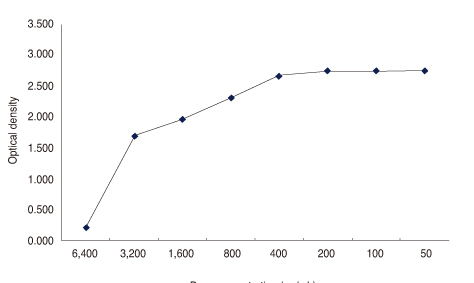Korean J Ophthalmol.
2013 Jun;27(3):199-203. 10.3341/kjo.2013.27.3.199.
Anti-adenoviral Effects of Human Cationic Antimicrobial Protein-18/LL-37, an Antimicrobial Peptide, by Quantitative Polymerase Chain Reaction
- Affiliations
-
- 1Department of Ophthalmology, Fukuoka University School of Medicine, Fukuoka, Japan. euchio@fukuoka-u.ac.jp
- 2Department of Ophthalmology, Yokohama City University Medical Center, Yokohama, Japan.
- KMID: 1798058
- DOI: http://doi.org/10.3341/kjo.2013.27.3.199
Abstract
- PURPOSE
Antimicrobial peptides have an important role in self-protection of the ocular surface. Human cationic antimicrobial protein (hCAP)-18 is a linear, alpha-helical peptide that consists of a conserved pro-sequence called a cathelin-like domain and a C-terminal peptide named LL-37. We investigated the in vitro anti-adenoviral activity of hCAP-18/LL-37 in several adenovirus types, inducing keratoconjunctivitis.
METHODS
A549 cells were used for viral cell culture, and human adenovirus (HAdV) types 3 (HAdV3, species B), 4 (species E), 8, 19a, and 37 (species D) were used. The cytotoxicity of LL-37 was evaluated by 3-(4,5-dimethylthiazol-2-yl)-5-(3-carboxymethoxyphenyl)-2-(4-sulfophenyl)-2H-tetrazolium (MTS) assay to obtain 50% cytotoxic concentration. After pretreatment of A549 cells with serial dilutions of LL-37 for 24 hours, adenovirus was cultured for seven days, and adenoviral DNA was quantitatively measured by real-time polymerase chain reaction (PCR).
RESULTS
The 50% effective concentration of LL-37 obtained by real-time PCR ranged between 118 and 270 microM. LL-37 showed a significant inhibitory effect on adenoviral proliferation in all adenovirus types except HAdV4 in a dose-dependent manner.
CONCLUSIONS
LL-37 has significant inhibitory activity against HAdV3, 8, and 19, which induce keratoconjunctivitis. These results indicate that hCAP-18/LL-37 may be a possible candidate for the treatment of HAdV keratoconjunctivitis.
Keyword
MeSH Terms
-
Adenocarcinoma
Adenoviridae/*drug effects/*genetics
Adenoviridae Infections/*drug therapy/virology
Antimicrobial Cationic Peptides/*pharmacology
Cell Line, Tumor
DNA, Viral/genetics
Humans
Keratoconjunctivitis/*drug therapy/virology
Lung Neoplasms
Reverse Transcriptase Polymerase Chain Reaction/methods
Antimicrobial Cationic Peptides
DNA, Viral
Figure
Reference
-
1. De Jong JC, Wermenbol AG, Verweij-Uijterwaal MW, et al. Adenoviruses from human immunodeficiency virus-infected individuals, including two strains that represent new candidate serotypes Ad50 and Ad51 of species B1 and D, respectively. J Clin Microbiol. 1999. 37:3940–3945.2. Walsh MP, Seto J, Jones MS, et al. Computational analysis identifies human adenovirus type 55 as a re-emergent acute respiratory disease pathogen. J Clin Microbiol. 2010. 48:991–993.3. Kaneko H, Aoki K, Ohno S, et al. Complete genome analysis of a novel intertypic recombinant human adenovirus causing epidemic keratoconjunctivitis in Japan. J Clin Microbiol. 2011. 49:484–490.4. Kaneko H, Suzutani T, Aoki K, et al. Epidemiological and virological features of epidemic keratoconjunctivitis due to new human adenovirus type 54 in Japan. Br J Ophthalmol. 2011. 95:32–36.5. Boman HG. Innate immunity and the normal microflora. Immunol Rev. 2000. 173:5–16.6. Zasloff M. Antimicrobial peptides of multicellular organisms. Nature. 2002. 415:389–395.7. Zanetti M, Gennaro R, Romeo D. Cathelicidins: a novel protein family with a common proregion and a variable C-terminal antimicrobial domain. FEBS Lett. 1995. 374:1–5.8. Huang LC, Petkova TD, Reins RY, et al. Multifunctional roles of human cathelicidin (LL-37) at the ocular surface. Invest Ophthalmol Vis Sci. 2006. 47:2369–2380.9. Bals R, Wang X, Zasloff M, Wilson JM. The peptide antibiotic LL-37/hCAP-18 is expressed in epithelia of the human lung where it has broad antimicrobial activity at the airway surface. Proc Natl Acad Sci U S A. 1998. 95:9541–9546.10. Frohm M, Agerberth B, Ahangari G, et al. The expression of the gene coding for the antibacterial peptide LL-37 is induced in human keratinocytes during inflammatory disorders. J Biol Chem. 1997. 272:15258–15263.11. Gudmundsson GH, Agerberth B, Odeberg J, et al. The human gene FALL39 and processing of the cathelin precursor to the antibacterial peptide LL-37 in granulocytes. Eur J Biochem. 1996. 238:325–332.12. Gordon YJ, Huang LC, Romanowski EG, et al. Human cathelicidin (LL-37), a multifunctional peptide, is expressed by ocular surface epithelia and has potent antibacterial and antiviral activity. Curr Eye Res. 2005. 30:385–394.13. McDermott AM. The role of antimicrobial peptides at the ocular surface. Ophthalmic Res. 2009. 41:60–75.14. Nagaoka I, Hirota S, Niyonsaba F, et al. Cathelicidin family of antibacterial peptides CAP18 and CAP11 inhibit the expression of TNF-alpha by blocking the binding of LPS to CD14(+) cells. J Immunol. 2001. 167:3329–3338.15. Turner J, Cho Y, Dinh NN, et al. Activities of LL-37, a cathelin-associated antimicrobial peptide of human neutrophils. Antimicrob Agents Chemother. 1998. 42:2206–2214.16. Noda M, Otagaki Y, Ikeda Y, et al. Genome types of adenovirus types 19 and 37 isolated from patients with conjunctivitis in Hiroshima City. J Med Virol. 1988. 26:15–22.17. Miura-Ochiai R, Shimada Y, Konno T, et al. Quantitative detection and rapid identification of human adenoviruses. J Clin Microbiol. 2007. 45:958–967.18. Shayakhmetov DM, Lieber A. Dependence of adenovirus infectivity on length of the fiber shaft domain. J Virol. 2000. 74:10274–10286.19. Ishiko H, Shimada Y, Konno T, et al. Novel human adenovirus causing nosocomial epidemic keratoconjunctivitis. J Clin Microbiol. 2008. 46:2002–2008.20. Naesens L, Lenaerts L, Andrei G, et al. Antiadenovirus activities of several classes of nucleoside and nucleotide analogues. Antimicrob Agents Chemother. 2005. 49:1010–1016.21. Uchio E, Fuchigami A, Kadonosono K, et al. Anti-adenoviral effect of anti-HIV agents in vitro in serotypes inducing keratoconjunctivitis. Graefes Arch Clin Exp Ophthalmol. 2007. 245:1319–1325.22. Uchio E, Inoue H, Kadonosono K. Antiadenoviral effects of N-chlorotaurine in vitro confirmed by quantitative polymerase chain reaction methods. Clin Ophthalmol. 2010. 4:1325–1329.23. Uchio E, Kimura R, Huang YH, et al. Antiadenoviral effect of the alpha 5 beta 1 integrin receptor ligand, GRGDSP peptide, in serotypes that cause acute keratoconjunctivitis. Ophthalmologica. 2007. 221:326–330.24. Smith JG, Silvestry M, Lindert S, et al. Insight into the mechanisms of adenovirus capsid disassembly from studies of defensin neutralization. PLoS Pathog. 2010. 6:e1000959.
- Full Text Links
- Actions
-
Cited
- CITED
-
- Close
- Share
- Similar articles
-
- Cathelicidin LL-37: An Antimicrobial Peptide with a Role in Inflammatory Skin Disease
- Antimicrobial Peptide (LL-37) Expression In Nasal Mucosa
- Expression and Modulation of LL-37 in Normal Human Keratinocytes, HaCaT cells, and Inflammatory Skin Diseases
- LL-37 inhibits serum amyloid A-induced IL-8 production in human neutrophils
- Application of Antimicrobial Peptide LL-37 as an Adjuvant for Middle East Respiratory Syndrome-Coronavirus Antigen Induces an Efficient Protective Immune Response Against Viral Infection After Intranasal Immunization


